
This is a list of the National Register of Historic Places listings in Clarke County, Alabama.

This is a list of the National Register of Historic Places listings in Jackson County, Alabama.
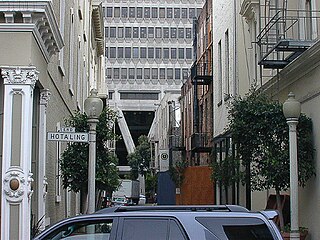
Jackson Square Historic District is an area in downtown San Francisco, California. It dates back to the city's earliest years and the 1849 gold rush, and is known for its historic commercial buildings in the classical revival and Italianate styles.

Mount Auburn Historic District is located in the Mount Auburn neighborhood of Cincinnati, Ohio. It extends along both sides of Auburn Avenue roughly between Ringold Street and William H. Taft Road. The population of Mount Auburn was 5,094 at the 2020 census.
The Seth Lore and Irwinton Historic District is a historic district in Eufaula, Barbour County, Alabama, United States. It was listed on the National Register of Historic Places in 1973 as Lore Historic District; the registration document identified and described 72 specific buildings. And then its boundaries were increased and the district was renamed to "Seth Lore and Irwinton Historic District" in 1986; the entire area then contained 738 contributing buildings.
The Old Dauphin Way Historic District is a historic district in the city of Mobile, Alabama, United States. It was named for Dauphin Way, now known as Dauphin Street, which bisects the center of the district from east to west. The district is roughly bounded by Broad Street on the east, Springhill Avenue on the north, Government Street on the south, and Houston Avenue on the west. Covering 766 acres (3.10 km2) and containing 1466 contributing buildings, Old Dauphin Way is the largest historic district in Mobile.

The Ashland Place Historic District is a historic district in the city of Mobile, Alabama, United States. The neighborhood gained its name from a Greek Revival antebellum house called Ashland that once stood on Lanier Avenue. Ashland was famous as the home of Augusta Evans Wilson. The house burned in 1926. The Ashland Place Historic District was placed on the National Register of Historic Places on June 23, 1987. It is roughly bounded by Spring Hill Avenue, Ryan Avenue, Old Shell Road, and Levert Avenue. The district covers 400 acres (1.6 km2) and contains 93 contributing buildings. The majority of the buildings date to the early 20th century and cover a variety of historical architectural styles ranging from late Victorian to the Craftsman styles.
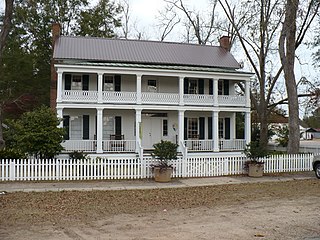
The Alston–Cobb House, now formally known as the Clarke County Historical Museum, is a historic house and local history museum in Grove Hill, Alabama, United States. It was built in 1854 by Dr. Lemuel Lovett Alston as a Greek Revival I-house, a vernacular style also known in the South as Plantation Plain. It is one of only four examples of an I-house to survive intact in Clarke County. The Alston–Cobb House was added to the Alabama Register of Landmarks and Heritage on September 1, 1978, and to the National Register of Historic Places on April 30, 1979.

The Thomasville Historic District is a historic district in the city of Thomasville, Alabama, United States. Thomasville was founded in 1888, along the then newly constructed railroad between Mobile and Selma. The city's business district suffered a major fire in 1899, with only one brick building surviving. The historic district features examples of early commercial, Queen Anne, Colonial Revival, Craftsman, and regional vernacular architecture. The historic district is centered on the old business district and is roughly bounded by U.S. Highway 43, West Front Street, Wilson Street, and West Third Street. It is a part of the Clarke County Multiple Property Submission and was placed on the National Register of Historic Places on February 12, 1999.
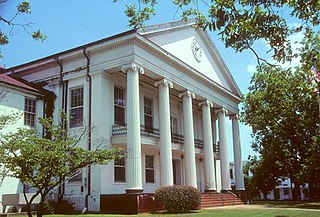
The Marion Courthouse Square Historic District is a historic district in Marion, Alabama. It is centered on the Perry County Courthouse and includes examples of Greek Revival, Gothic Revival, and Tudor Revival architecture. The boundaries are roughly along Green, Washington, Jefferson, Jackson, Franklin, Clements, Centreville and Monroe Streets. It was added to the National Register of Historic Places on February 16, 1996.

The Grove Hill Courthouse Square Historic District is a historic district in Grove Hill, Alabama, United States. It is centered on the Clarke County Courthouse and the boundaries are roughly Cobb, Court, Jackson, and Main Streets. It features examples of Greek Revival and Queen Anne architecture. The district was added to the Alabama Register of Landmarks and Heritage on March 24, 1995, and to the National Register of Historic Places on April 30, 1998.
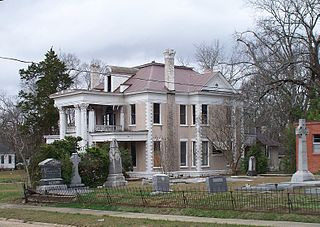
The Uniontown Historic District is a historic district in Uniontown, Alabama. It is roughly bounded by Tomasene Street, Taylor Street, East Avenue, and Green Street. It contains a variety of mid-to-late 19th and early 20th century architectural styles, most notably examples of Greek Revival, Queen Anne, and Classical Revival. The district was added to the National Register of Historic Places on February 24, 2000.

The Garden District is a 315-acre (127 ha) historic district in Montgomery, Alabama.

The Downtown Athens Historic District is a historic area in the Downtown Athens neighborhood of Athens, Georgia. It was listed on the National Register of Historic Places in 1978. Its boundaries were revised twice, in 1984 and 2006, and additional documentation was filed in 2006.
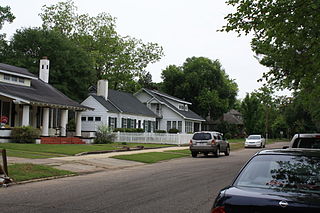
The Icehouse Historic District is a 116-acre (47 ha) historic district in Selma, Dallas County, Alabama. It is bounded by J.L. Chestnut, Jr. Boulevard on the north, the banks of Valley Creek on the west, Dallas Avenue on the south, and Union and Lapsley streets on the east. The district includes examples of the Tudor Revival, American Craftsman, Colonial Revival, and other early 20th century residential styles. It contains 213 contributing buildings and 141 noncontributing structures. The district is a neighborhood of small wood-frame and brick residences housing a mixture of low and middle-income families along tree-lined streets. It was added to the National Register of Historic Places on June 28, 1990.

The Old Town Historic District is a 323-acre (131 ha) historic district in Selma, Dallas County, Alabama. It is bounded by U.S. Route 80, Broad and Franklin streets, and Dallas and Selma avenues. The boundaries were increased on December 15, 2003. The district includes examples of the Federal, Greek Revival, Italianate, Gothic Revival, Victorian, Shotgun, Queen Anne, Romanesque Revival, Renaissance Revival, and Classical Revival.

The Riverview Historic District is an 86-acre (35 ha) historic district in Selma, Dallas County, Alabama. It is bounded by Selma Avenue, Satterfield and Lapsley streets, and the Alabama River. The district includes examples of the Tudor Revival, Colonial Revival, American Craftsman, and several Queen Anne styles. Primarily residential, it contains 204 contributing properties and 54 noncontributing properties. The district is representative of the prosperity of people in the city at the turn of the 20th century. This time marked a period of major growth for the middle and working-class population. The district was added to the National Register of Historic Places on June 28, 1990.
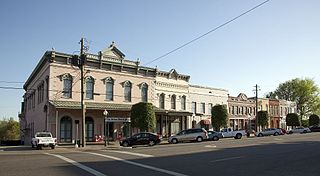
The Water Avenue Historic District is a 10-acre (4.0 ha) historic district in Selma, Dallas County, Alabama. It is centered on Water Avenue in downtown. The boundaries were increased on July 7, 2005. The district is primarily commercial, with examples of the Greek Revival, Italianate, Queen Anne, Romanesque Revival, and Renaissance Revival styles. It contains 52 properties, with 47 contributing and 5 noncontributing to the district. It was added to the National Register of Historic Places on December 26, 1972, with boundary increases in 2005 and 2021.

The Chambers County Courthouse Square Historic District comprises the central portion of LaFayette, Alabama, United States, centered on the Chambers County Courthouse. The courthouse is located in a square, surrounded by an early 20th century commercial district on LaFayette Street, Alabama Avenue, First Street SE and First Avenue. The district includes 63 buildings, of which 45 are considered contributing features. It is described as one of the most intact courthouse squares in Alabama.
Woodlawn, Alabama is a community in Jefferson County, Alabama, which is now a neighborhood within the city of Birmingham, Alabama. It grew as an independent community, and became the City of Woodlawn, and built a substantial City Hall building in 1908, but was annexed by Birmingham in 1910. The community area experienced a surge of growth after it was annexed.



















